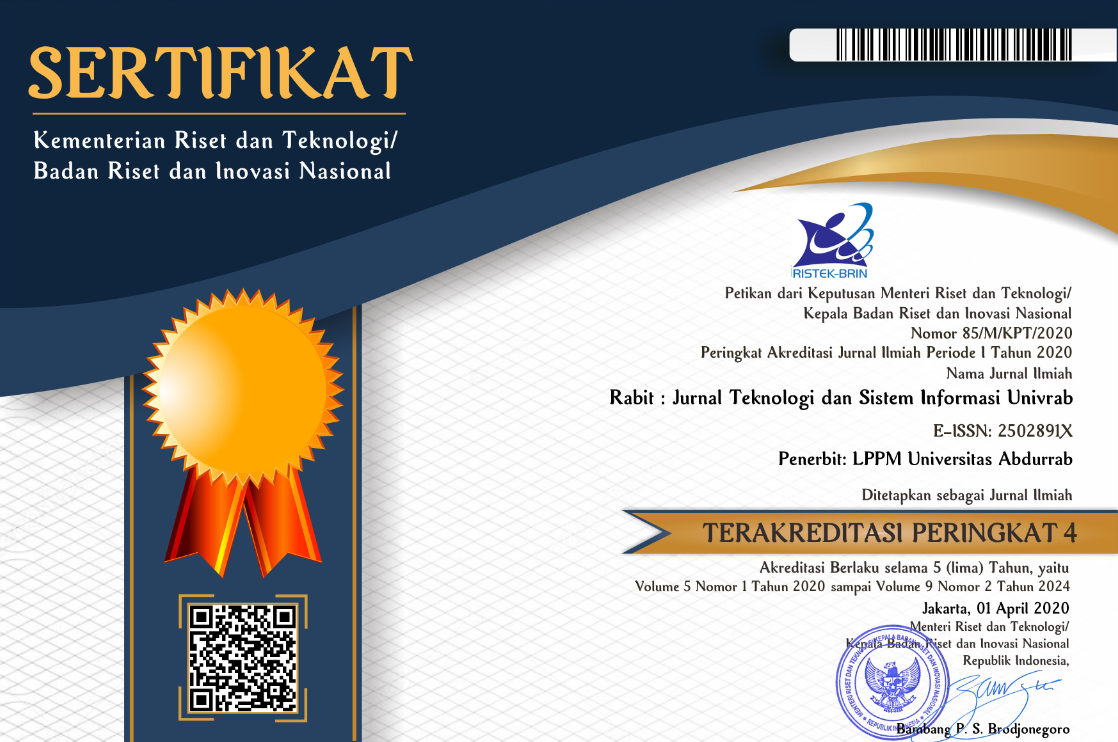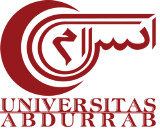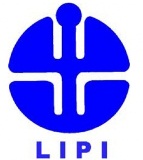SISTEM SELEKSI PENERIMAAN TENAGA KERJA OUTSOURCING MENGGUNAKAN ALGORITMA C5.0 BERBASIS ANDROID (STUDI KASUS : PT. SINERGI INDO PRIMA MEDAN)
Abstract
PT. Sinergi Indo Prima is a company that supports employment services or called outsourcing. Services included in the outsourcing are security guards, administrative staff, factory workers, drivers, sales promoters, and cleaning services. As for looking for prospective workers PT. Sinergi Indo Prima Medan has a problem, namely the system is still manual, data input only uses Microsoft Excel or does not have a professional decision support system in selecting prospective workers who meet the criteria, so that the prospective workers to be distributed are not in accordance with the competencies of the areas of expertise assigned to them. required by companies in need. In this study the author uses the Rapid Application Development (RAD) development method, using the C5.0 Algorithm, with the support of Unified Modeling Language (UML) tools using the Java programming language based on Android Studio, Microsoft Visio and Umlet to design the interface. The results of the design of the recruitment selection system for outsourcing prospective workers is an application called AKSIP which is used for the data selection process for prospective workers in each job category, while the results of testing data from 6 job categories using the C5.0 Algorithm achieve a success percentage of accuracy value of 94%
References
K. W. Ap, “Implementasi Algoritma C4 . 5 untuk Perekrutan Karyawan Berbasis Android ( Studi Kasus : Blackberry Service Center Medan ),” 2018.
Samsudin, “Penentuan Penerimaan Remunerasi Dosen Dengan Rule Based Reasoning,” Medan, 2018. [Online]. Available: file:///E:/SKRIPSI - New File/S K R I P S I/SKRIPSI/Daftar Referensi Proposal Skripsi/Laporan Penelitian Samsudin (1).pdf.
Samsudin, “Optimalisasi Penerimaan Remunerasi Dosen Menggunakan Metode Rule Base Reasoning,” Kumpul. J. Ilmu Komput., vol. 06, no. 3, pp. 224–240, 2019.
L. M. Yulyantari and I. P. Wijaya, Manajemen Model Pada Sistem Pendukung Keputusan. Yogyakarta: CV. Andi Offset, 2019.
A. Ikhwan, S. B. Siagian, S. Mawaddah, M. Annisah, and S. Informasi, “Penerima Beras Raskin Dengan Metode Fuzzy,” vol. 9, no. 2, pp. 457–463, 2019.
I. M. Sudarma, “Implementasi Algoritma C5 . 0 pada Penilaian,” Maj. Ilm. Teknol. Elektro, vol. 17, no. 3, pp. 1–6, 2018.
E. T. Kusrini, Luthfi, Algoritma Data Mining. Yogyakarta: CV. Andi Offset, 2009.
A. C. Wijaya, N. A. Hasibuan, and P. Ramadhani, “Implementasi Algoritma C5 . 0 Dalam Klasifikasi Pendapatan Masyarakat ( Studi Kasus : Kelurahan Mesjid Kecamatan Medan Kota ),” Inf. dan Teknol. Ilm., vol. 13, pp. 192–198, 2018.
C. Hutabarat, “Penerapan Data Mining Untuk Memprediksi Permintaan Produk Kartu Perdana Internet Menggunakan Algoritma C5.0 (Studi Kasus: Vidha Ponsel),” J. Pelita Inform., vol. 17, no. 2, pp. 168–173, 2018.
J. Andi, “Pembangunan Aplikasi Child Tracker Berbasis Assisted – Global Positioning System ( A-GPS ) Dengan Platform Android,” J. Ilm. Komput. dan Inform., vol. 1, no. 1, pp. 1–8, 2015, [Online]. Available: elib.unikom.ac.id/download.php?id=300375.
Suendri, “Implementasi Diagram UML (Unified Modelling Language) Pada Perancangan Sistem Informasi Remunerasi Dosen Dengan Database Oracle (Studi Kasus: UIN Sumatera Utara Medan),” vol. 6341, no. November, pp. 1–9, 2018.
M. H. Fakhriza and Ispandi, “Sistem Penunjang Keputusan Kenaikan Jabatan Pada PT.Metraplasa,” Gerbang, vol. 8, no. 1, pp. 73–79, 2018.
J. R. Sagala, “Model Rapid Application Development (Rad) Dalam Pengembangan Sistem Informasi Penjadwalan Belajar Mengajar,” J. Mantik Penusa, vol. 2, no. 1, pp. 87–90, 2018.
W. Aprianti and U. Maliha, “Sistem Informasi Kepadatan Penduduk Kelurahan Atau Desa Studi Kasus Pada Kecamatan Bati-Bati,” vol. 2, no. 2013, pp. 21–28, 2016.

This work is licensed under a Creative Commons Attribution-NonCommercial-ShareAlike 4.0 International License.
Copyright Notice
The copyright of the received article shall be assigned to the publisher of the journal. The intended copyright includes the right to publish the article in various forms (including reprints). The journal maintains the publishing rights to published articles. Therefore, the author must submit a statement of the Copyright Transfer Agreement.*)
This work is licensed under a Creative Commons Attribution-NonCommercial-ShareAlike 4.0 International License.
In line with the license, authors and any users (readers and other researchers) are allowed to share and adapt the material only for non-commercial purposes. In addition, the material must be given appropriate credit, provided with a link to the license, and indicated if changes were made. If authors remix, transform or build upon the material, authors must distribute their contributions under the same license as the original.
Please find the rights and licenses in RABIT : Jurnal Teknologi dan Sistem Informasi Univrab. By submitting the article/manuscript of the article, the author(s) accept this policy.
1. License
The non-commercial use of the article will be governed by the Creative Commons Attribution license as currently displayed on Creative Commons Attribution-NonCommercial-ShareAlike 4.0 International License.
2. Author’s Warranties
The author warrants that the article is original, written by stated author(s), has not been published before, contains no unlawful statements, does not infringe the rights of others, is subject to copyright that is vested exclusively in the author and free of any third party rights, and that any necessary written permissions to quote from other sources have been obtained by the author(s).
3. User Rights
RABIT's spirit is to disseminate articles published are as free as possible. Under the Creative Commons license, RABIT permits users to copy, distribute, display, and perform the work for non-commercial purposes only. Users will also need to attribute authors and RABIT on distributing works in the journal.
4. Rights of Authors
Authors retain all their rights to the published works, such as (but not limited to) the following rights;
- Copyright and other proprietary rights relating to the article, such as patent rights,
- The right to use the substance of the article in own future works, including lectures and books,
- The right to reproduce the article for own purposes,
- The right to self-archive the article,
- The right to enter into separate, additional contractual arrangements for the non-exclusive distribution of the article's published version (e.g., post it to an institutional repository or publish it in a book), with an acknowledgment of its initial publication in this journal (RABIT : Jurnal Teknologi dan Sistem Informasi Univrab).
5. Co-Authorship
If the article was jointly prepared by other authors, any authors submitting the manuscript warrants that he/she has been authorized by all co-authors to be agreed on this copyright and license notice (agreement) on their behalf, and agrees to inform his/her co-authors of the terms of this policy. RABIT will not be held liable for anything that may arise due to the author(s) internal dispute. RABIT will only communicate with the corresponding author.
6. Royalties
This agreement entitles the author to no royalties or other fees. To such extent as legally permissible, the author waives his or her right to collect royalties relative to the article in respect of any use of the article by RABIT.
7. Miscellaneous
RABIT will publish the article (or have it published) in the journal if the article’s editorial process is successfully completed. RABIT's editors may modify the article to a style of punctuation, spelling, capitalization, referencing and usage that deems appropriate. The author acknowledges that the article may be published so that it will be publicly accessible and such access will be free of charge for the readers as mentioned in point 3.
 PDF (Bahasa Indonesia)
PDF (Bahasa Indonesia)
 Abstract views: 968
Abstract views: 968
 downloads: 842
downloads: 842

 :
:












